IAN as a Boundary Organization
Bill Dennison ·
My first reaction to being invited to talk about Integration and Application Network (IAN) as a boundary organization was to ask, “What is a boundary organization?”. I looked up some definitions and liked the one that described a boundary organization in the following manner: “Organizations that facilitate collaboration and information flow between diverse research disciplines and between the research and public policy community”. This definition is found on the National Socio-Environmental Research Center (SESYNC) website.
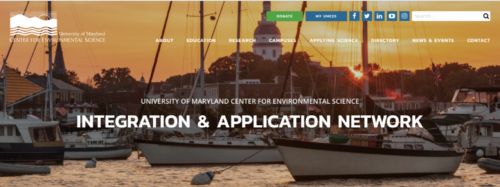
The genesis of IAN was in the 2000 strategic plan for the University of Maryland Center for Environmental Science (UMCES). The UMCES faculty resolved that instead of documenting the decline of Chesapeake Bay as they had been doing for decades, they wanted to use their science to help solve environmental problems. This led to faculty embracing the Ernest Boyer (1990) concept of scholarship as being a) discovery, b) integration, c) application and d) teaching. In order to develop a strong integration and application component, UMCES established the Integration and Application Network, which conveniently is the name of the late Dr. Ian Morris, former UMCES President. UMCES President Don Boesch was able to go to the Maryland state legislature and obtain funding to establish IAN and the newly created position of Vice President for Science Application. I was hired in 2002 in this position and started building IAN.
IAN started out modestly with one employee (Dr. Tim Carruthers) and we recruited some of my former University of Queensland students over time (Dr. Adrian Jones, Tracey Saxby, Jane Thomas, Dr. Ben Longstaff, Dr. Simon Costanzo). We had started producing conceptual diagrams to support the Healthy Waterways Campaign of Southeast Queensland, so one of the first things we did was to develop a symbol library and a website to host it so that others could use our symbols to create their own conceptual diagrams. The symbol library has grown (almost 3,000 symbols) as well as its reach—we currently have nearly 100,000 registered users from virtually every country in the world. We envision creating a global symbol language. We also began teaching science communication courses and published a Communicating Science Effectively handbook (Thomas et al., 2004).
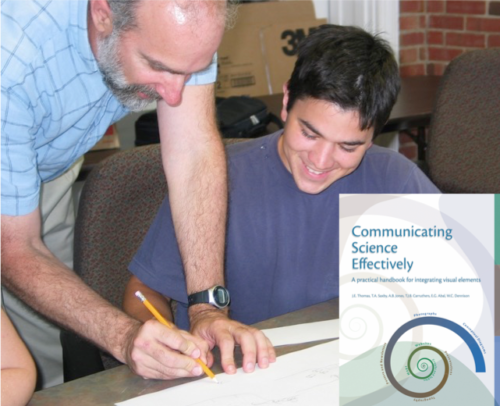
The small IAN team started producing synthesis documents, and we developed some enduring partnerships with the National Park Service and the Maryland Coastal Bays Program. We realized that we needed both Science Integrators (PhD level scientists with facilitation and synthesis skills) and Science Communicators (M.S. level scientists with graphic arts and coordination skills). We added an intern program and began including graduate students as well. At first, we had difficulties recruiting people for these nontraditional jobs, but now each job advertisement that we post generates dozens of highly qualified applicants.
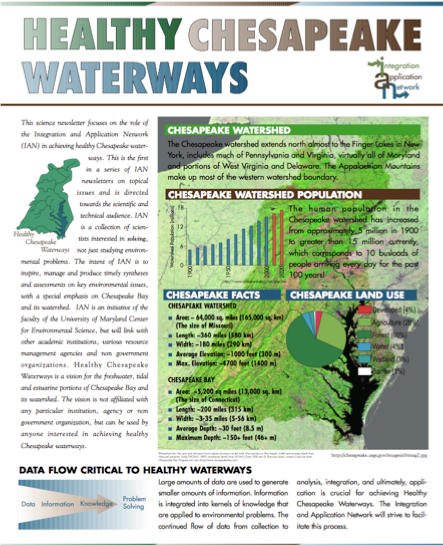
In 2009, we launched IAN Press so that we could produce
inexpensive, full color, synthetic books, brochures, newsletters and posters.
We are now up 400 publications on IAN Press. We also launched our first IAN
environmental report card for Chesapeake Bay, emulating report cards we had
developed in Southeast Queensland, Australia. We have gone on to produce report
cards all over the world. We created a website to host many of the report cards
(ecoreportcard.org).

IAN created a novel academic business model. We made it clear on
our website that we would like to work collaboratively on important issues
where our facilitation, synthesis and communication skills were useful. We
started working with a wide diversity of partners who created a work-of-mouth
network that had groups from federal, state and local governments, large and
small non-governmental organizations, foundations, academic institutions and
societies, as well as some citizen science groups approaching us to work with
them. This business model has resulted in almost all of our proposals being
funded since we pre-negotiate the terms and budgets, thus saving ourselves from
writing unsuccessful proposals.

IAN has continued to teach, including using interactive video
conferencing to expand to global classrooms from multiple continents taking our
training courses. We typically provide lectures before class time by creating
short YouTube videos. The class time discussions are summarized in weekly
blogs. We also construct course websites to organize the lectures, blogs and
student projects.
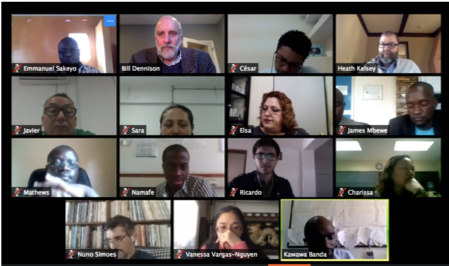
IAN partnered with GreenSmith, conservation-based media consultants to expand our media reach. For example, now our Chesapeake Bay report card releases reach tens of millions of people, up 150 million through traditional and social media outlets.
IAN developed for fifteen years without a strategic plan, but we recently developed the IAN Strategic Plan (2017-2022). In this plan, we established our Theory of Change. We start with our internal activities, promoting financial viability, functionality, capacity building and staff happiness. We then engage with strategic partners who help us magnify our social impact with the intent of creating positive ecological outcomes. In order to self-evaluate ourselves, we set up an introspective report card to assess our internal processes and an annual external report card to assess our partner engagement, social impact and ecological outcomes. Included in our assessment is the status of two local waterways, the Maryland Coastal Bays and Chesapeake Bay. Taking responsibility for the status of something we only have partial control over is bold, but consistent with our values and our vision.

We can think of IAN as a boundary organization within academia as
being the intersection between natural science, social science and humanities
& arts. For the natural sciences, IAN regularly conducts data analyses and
syntheses to construct graphs, figures and tables in the natural sciences. IAN
is employing more social science tools like social network analysis, cultural
consensus and both qualitative and quantitative surveys. IAN also regularly
produces conceptual diagrams and uses photographs and videos with staff trained
in the arts. In addition, IAN staff produce poems and songs to summarize
workshops and activities.
We can also think of IAN as a transdisciplinary boundary organization in the intersection between academia, practitioners and stakeholders. IAN will convene academia researchers in projects like the recent Submerged Aquatic Vegetation synthesis (SAV SYN). IAN works with a variety of practitioners such as federal agencies like the National Park Service and U.S. Geological Survey as well as NGOs like World Wildlife Fund or the Maryland Coastal Bays Program. IAN often works directly with stakeholders like the Ingram Barge Company and Caterpillar who helped us build the Mississippi River report card.
IAN also serves as a boundary organization in the approach of
simultaneously attempting to both study and solve environmental problems. The
juxtaposition of being dispassionate, embracing complexity, scientific peer
review and getting it right to study problems vs, being passionate,
simplifying, stakeholders review and getting it done to solve problems is
something that our boundary organization can facilitate.
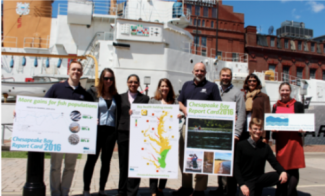
IAN has a unique culture. We pride ourselves in producing
products on time and on budget, unusual for academia. We have intense
collaborations with partners when we co-produce products. Our primary output is
science communication products for electronic or print media, not peer review
publications. Our primary audience is our partner’s audience, not our
scientific peers. Ultimately, our aim is to make a positive difference with
ecological outcomes. We aspire to the following 7 goals: 1) communicate science
effectively, 2) report ecosystem status, 3) teach and train others, 4) catalyze
conservation outcomes, 5) advance Chesapeake restoration, 6) build strategic
partnerships and 7) create good citizenship models.
IAN acts like a startup company. We are constantly trying new challenges, multi-tasking a diversity of projects, and conducting group learning with various professional development activities. IAN practices shared governance and IAN staff have fun with one another and with our partners. IAN is highly visible, productive, and low cost to the university, raising the question of why there are not more IAN-like boundary organizations? It does take an initial investment in terms of time and money to get started. A unique combination of skills are needed. It is a fundamentally new and different way of doing business, requiring a nimble administration, multitasking staff and managing variable project lengths. The reward systems are different than traditional academia, which can be challenging for recruitment and retention. There are a few examples of former IAN personnel forming boundary organizations (e.g., Hodge Environmental, Chesapeake Environmental Communications, My Sea My Story) or participating in them (e.g., Northern Australia Environmental Resources Hub, The Water Institute of the Gulf).
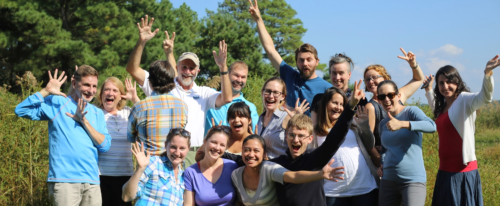
In the future, IAN will continue to diversify its science
communication products, generate more peer review publications, expand our
global teaching efforts, and expand our report cards to include social-economic
indicators, raise the grade activities and social network analysis.
As a way to summarize, I composed the following poem:
IAN Knows No Boundaries
William C. Dennison
20 Mar 2019
I was in a quandary
IAN is on a boundary?
I wanted to be firm,
What exactly is this term?
“Boundary organization”
Is that just academic inflation?
IAN does work with many different kinds
We try to get people to share their minds.
It is often a difficult chore
But we always get asked back for more,
Because we employ social skills
And even recite poems for extra frills.
So if that qualifies for this definition
Then count us in for a rendition.
Breaking down all sorts of barriers
As ferocious as pit bull terriers
IAN is not some sort an aberration
It is in fact a “Boundary Organization”.
About the author
Bill Dennison

Dr. Bill Dennison is a Professor of Marine Science and Vice President for Science Application at the University of Maryland Center for Environmental Science.

